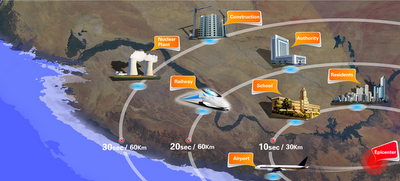Reporting earthquakes in real time is significant. If earthquakes can be reported to public within a few seconds after its occurrence, then areas that seismic waves have not reached will receive early warning and take timely evacuations and emergency actions . Facilities such as nuclear plants, trains, construction sites etc. should be shut off immediately. Current state-of-the-art technology, such as the one in Japan, could allow issuing earthquake early warning and telling location and magnitude within 5 seconds after receiving data on a monitoring network, but requiring 2 more minutes to estimate source focal mechanism, which is critical for issuing tsunami warning. Large and shallow reverse or normal faults could induce tsunami, but strike-slip earthquakes could not.

A sketch explaining the idea of earthquake early warning: an alert goes out within a couple of seconds of the earthquake occurrence, people immediately take nearby safety actions, high-speed trains, airport, nuclear plants and many other important facilities will immediately take urgent action and stop operations.
A USTC Geophysics Interdisciplinary Team applies computer fast search technology to develop an earthquake search engine with a large pre-established database and find the best seismogram match from database within a second. That means, the new technology allows reporting earthquake location, magnitude, and focal mechanism all within a second after receiving earthquake data. The three-year research results of the USTC team, entitled “Real-time earthquake monitoring using a search engine method”, published on Nature Communications on Dec 4, 2014. Authors include Prof. ZHANG Jie (Geophysics, China National 1000 Talents Professor), Prof. ZHANG Haijiang (Geophysics, China National 1000 Youth Talents Professor), Prof. CHEN Enhong (Computer Sciences, China National Outstanding Young Scientist), and Ph.D. candidates ZHENG Yi (Computer Sciences), KUANG Wenhuan (Geophysics), and ZHANG Xiong (Geophysics).
Nature Communications reviewers commented that the idea of earthquake search engine is "brilliant", "will have a great influence to earthquake early warning which requires both accuracy and rapidity." The idea of earthquake search engine was filed for a technology patent by the USTC team in over 41 countries, and Japan has just approved the patent. China Earthquake Administration (CEA) set up a national project to support the implementation of the new approach in their national earthquake monitoring network.

Prof. CHEN Enhong from Computer Sciences, Prof. YANG Zhouwang from Mathematics, and Prof. WU Jie from Physics are discussing research subjects with faculty members in the Geophysics Program at USTC.
Prof. ZHANG Jie, Director of USTC Geophysical Research Institute, initiated the geophysics interdisciplinary team when he joined USTC in 2011. Besides faculty members and students in the School of Earth and Space Sciences, 12 faculty members from Schools of Computer Sciences, Information Technology, Mathematics, and Physics also joined the team and collaborated on several geophysics projects.
(LUO Xiaomei, School of Earth and Space Sciences, School of Computer Science and Technology)

